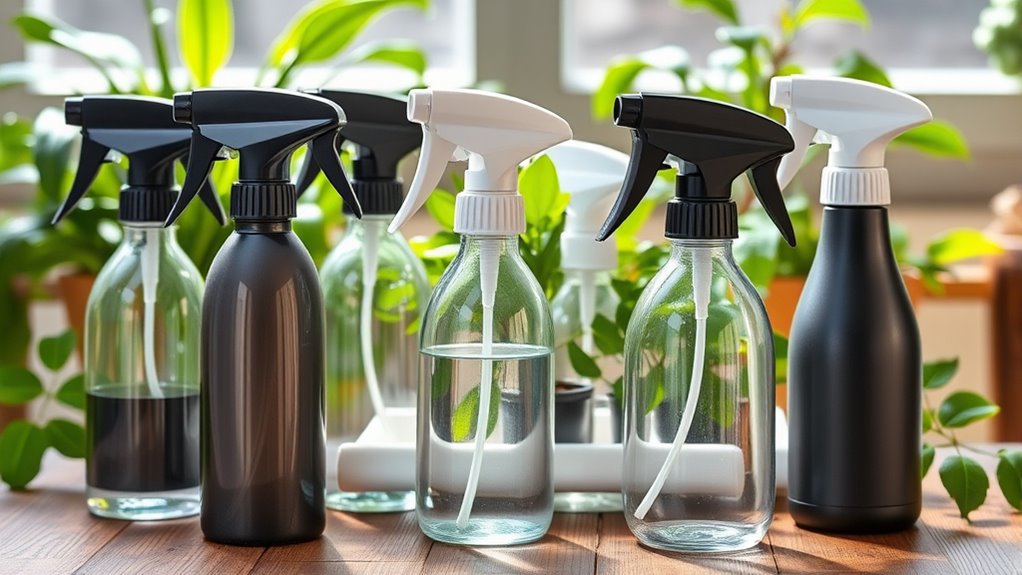I’ve explored the best plant misters and spray bottles that combine attractive designs, durability, and adjustable spray options for healthy, thriving plants. From compact indoor models to larger outdoor sprayers, there are solutions for every need. Whether you want a vintage glass mister or a high-capacity pressure sprayer, these choices help you water, clean, or care for your plants with ease. Keep going to discover detailed features and tips to pick the perfect one for your plants.
Key Takeaways
- Choose aesthetically appealing, ergonomic designs that provide fine, adjustable mist for optimal plant hydration and care.
- Opt for durable, eco-friendly materials like BPA-free plastic or stainless steel for long-lasting use.
- Select sizes and capacities suited to your plant types, from small indoor bottles to larger outdoor sprayers.
- Prioritize models with adjustable nozzles and leakproof seals for versatile, mess-free watering and misting.
- Consider user reviews and features like spray patterns, ease of cleaning, and compatibility with indoor and outdoor gardening needs.
Plant Mister Water Spray Bottle for Indoor Potted Plants
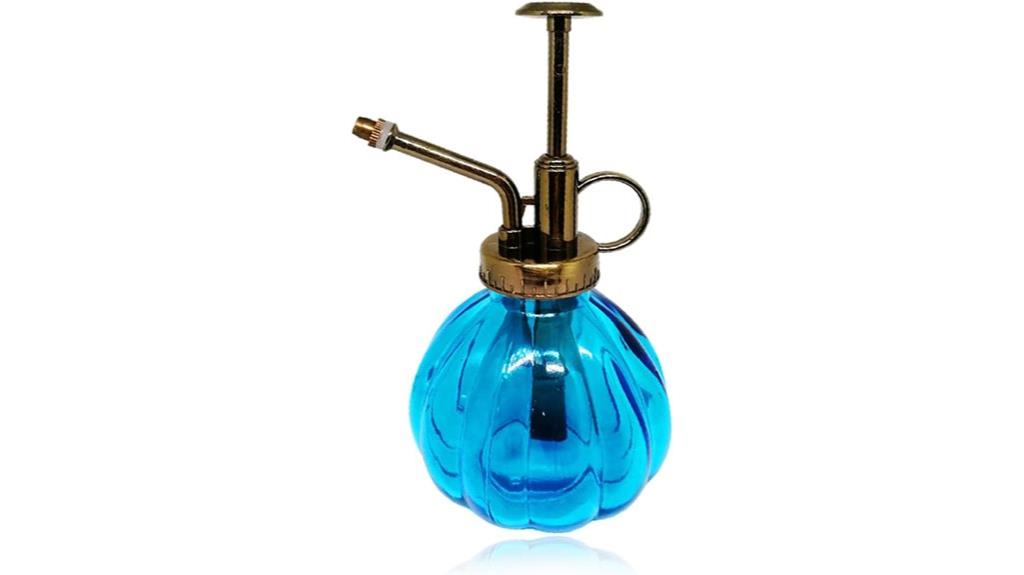
If you’re looking for a stylish and effective way to care for your indoor potted plants, the vintage-style glass plant mister is an excellent choice. With its 200ml capacity and charming pumpkin accents, it adds a retro touch to any decor. Made from eco-friendly, BPA-free, and lead-free materials, it’s safe and reusable. The adjustable nozzle lets you spray a fine mist or a steady stream, perfect for watering or misting leaves. Its compact size and lightweight design make it easy to handle. Although some plastic parts may be less durable, overall, it’s a beautiful, functional tool that enhances your plant care routine.
Best For: indoor plant enthusiasts seeking a stylish, eco-friendly, and easy-to-use watering and misting solution for their potted plants.
Pros:
- Attractive vintage design with charming pumpkin accents enhances decor
- Adjustable nozzle allows for fine mist or steady stream, versatile for watering and leaf misting
- Reusable, eco-friendly, and made from BPA-free and lead-free materials
Cons:
- Plastic components, such as the handle and plunger, may be less durable over time
- Leakage issues may occur when spraying at certain angles
- Limited capacity (200ml) may require frequent refilling during use
Spray Bottle for Plants 2 Pack, 16oz
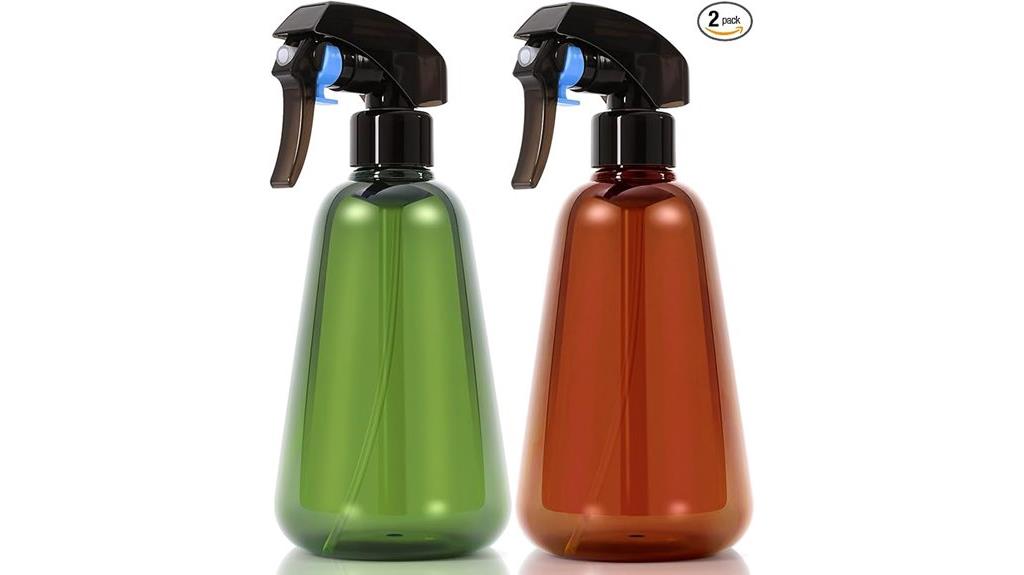
The Spray Bottle for Plants 2 Pack, 16oz, is an excellent choice for indoor gardeners who need gentle and precise misting. Its ultra-fine mist nozzle guarantees even, delicate coverage, perfect for sensitive plants like cacti, succulents, or seedlings. Made from durable, eco-friendly BPA-free plastic, these bottles are lightweight, ergonomic, and built to last through daily use. The leakproof 360° cap and tight seal prevent spills, while the semi-transparent design makes monitoring water levels easy. Whether for watering plants, cleaning, or hair styling, this 2-pack provides reliable, consistent performance that keeps your plants healthy and happy.
Best For: indoor gardeners, plant enthusiasts, and those seeking a gentle, eco-friendly misting solution for delicate plants, cleaning, or hair care.
Pros:
- Ultra-fine mist nozzle provides even, gentle coverage ideal for sensitive plants and seedlings
- Durable, eco-friendly BPA-free plastic construction ensures long-lasting use and safety
- Leakproof 360° cap and tight seal prevent spills, making it reliable for daily use
Cons:
- Hand wash only, which may be less convenient for some users
- No adjustable spray settings, limiting customization of mist intensity
- Semi-transparent design may require frequent refilling to monitor water levels
ExtremeMIST Garden Sprayer, 32 Oz Hand Pump Plant Mister
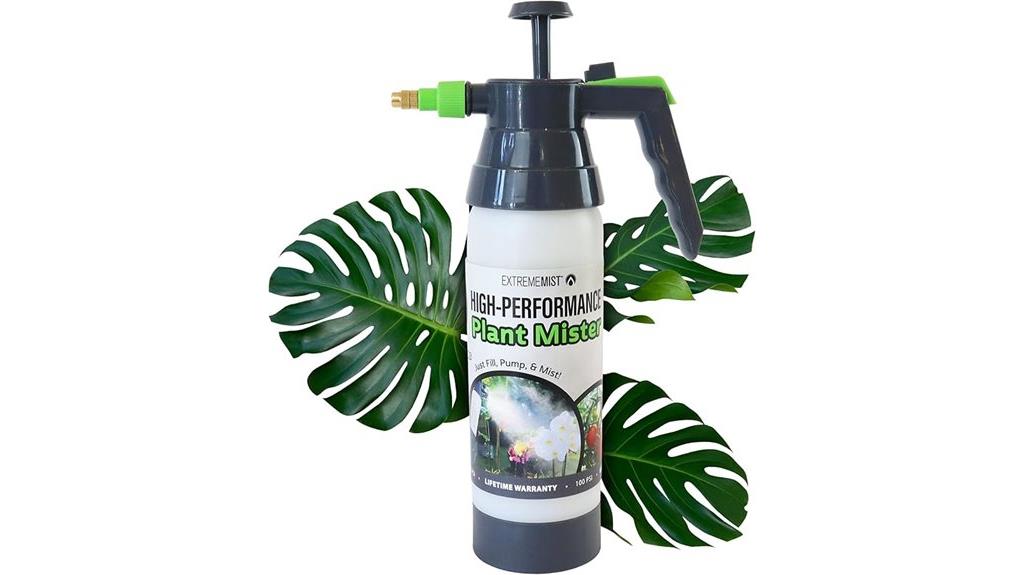
The ExtremeMIST Garden Sprayer is an excellent choice for gardeners who need precise and efficient watering or pest control. Its 32 oz capacity is perfect for indoor and outdoor use, and the durable polyethylene construction guarantees long-lasting performance. The adjustable brass nozzle allows me to switch from a fine mist to a powerful jet stream, making it versatile for different tasks. With a built-in pressure of up to 100 PSI, I get consistent, even spray with minimal effort. Its compact design makes it easy to handle and store, and I appreciate the transparent bottle that shows the water level. Overall, it’s a reliable tool for maintaining healthy, happy plants.
Best For: indoor and outdoor gardeners seeking a durable, versatile sprayer for plant watering, pest control, and foliar feeding.
Pros:
- Durable polyethylene construction with a lifetime warranty ensures long-lasting use
- Adjustable brass nozzle offers customizable mist or jet stream for various tasks
- Compact, lightweight design with a transparent water level window improves handling and monitoring
Cons:
- Some users report trigger sensitivity issues or inconsistent pressure release
- May struggle with foamy or bubbly fluids affecting spray quality
- Pressure retention can vary, requiring occasional re-pressurizing during extended use
OFFIDIX Transparent Glass Watering Spray Bottle, Plant Mister with Plastic Bronze Top Pump

Looking for a stylish and practical plant mister that complements your home decor? The OFFIDIX Transparent Glass Watering Spray Bottle offers a vintage Nordic look with its clear glass body and bronze plastic pump. Its compact size (200ml) makes it perfect for indoor plants like succulents and air plants. Made from BPA-free, eco-friendly materials, it’s reusable and safe. The sturdy glass feels premium, while the easy-to-use pump delivers a fine mist with one hand. Keep in mind, some users report leaks or nozzle issues, so proper assembly is key. Overall, it’s a beautiful, functional addition to any plant lover’s collection.
Best For: plant enthusiasts seeking a stylish, lightweight, and eco-friendly spray bottle for delicate indoor plants, air plants, or decorative watering.
Pros:
- Elegant vintage Nordic design that enhances home decor
- Compact and lightweight, easy to handle with one hand
- Produces a fine, even mist suitable for delicate plants and air plants
Cons:
- Limited capacity (200ml) may require frequent refilling
- Potential for leaks or nozzle issues if not assembled properly
- Plastic spray head may be less durable and prone to malfunction
Spray Bottle for Plants 2 Pack, 16oz
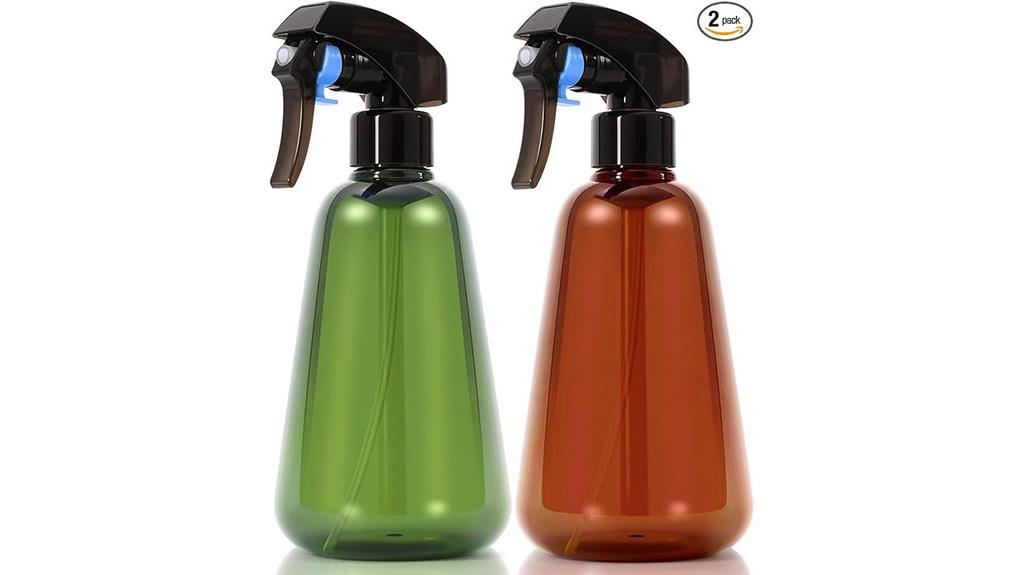
Are you searching for a reliable way to keep your indoor plants healthy and hydrated? The Spray Bottle for Plants 2 Pack, 16oz, is perfect for gentle misting, offering an ultra-fine spray that’s ideal for delicate plants, cacti, and seedlings. Made from durable, eco-friendly BPA-free plastic, these bottles are lightweight, ergonomic, and easy to handle. Their leakproof cap and tight seal prevent spills, making them perfect for daily use. With a 16-ounce capacity, they’re versatile for watering, cleaning, or even hair styling. Customers love their durability and fine mist, ensuring consistent, gentle hydration for healthy, thriving plants.
Best For: indoor gardeners, plant enthusiasts, and anyone needing a gentle mist for plants, hair, or cleaning.
Pros:
- Ultra-fine mist delivers gentle, even coverage suitable for delicate plants and seedlings
- Durable, BPA-free materials ensure long-term reuse and eco-friendliness
- Leakproof cap and tight seal prevent spills, making daily use convenient
Cons:
- Hand wash only, which may be less convenient for some users
- No adjustable spray settings, limiting customization of mist intensity
- Available only in green and brown colors, which may not match all aesthetic preferences
2 Pack Continuous Spray Bottles with Fine Mist Spray
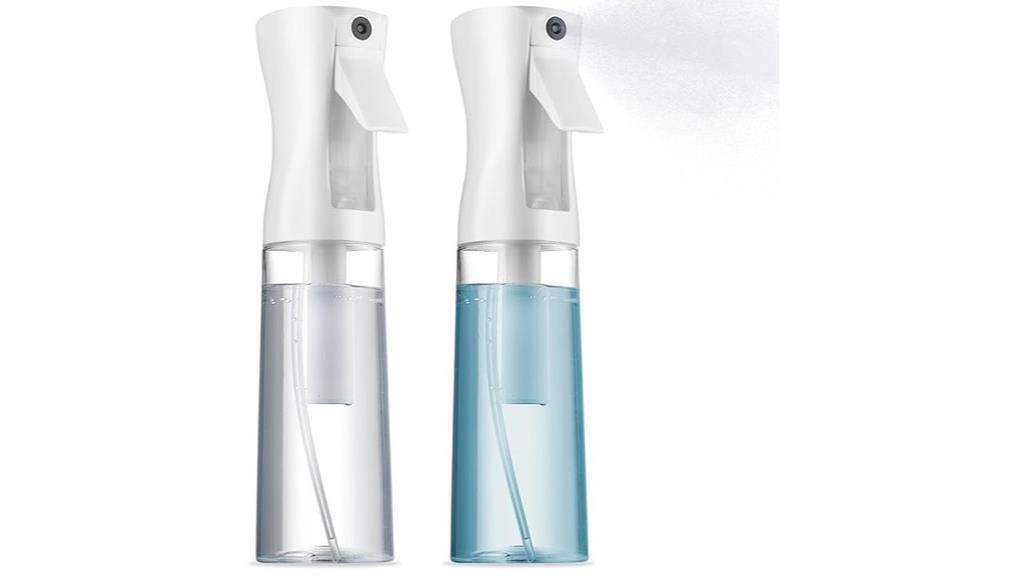
If you want a reliable spray bottle that delivers a fine, even mist with minimal effort, these 2-pack continuous spray bottles are an excellent choice. They hold 6.8 oz each and feature ultra-fine mist sprayers that evenly distribute water, oils, or cleaning solutions. The continuous spray mechanism reduces hand fatigue, providing a steady mist after just one trigger pull. Designed with an ergonomic, leak-proof build, these bottles are perfect for watering plants, humidifying, or household tasks. Their versatility and reliable performance make them a must-have for anyone seeking consistent, professional-quality misting without the hassle.
Best For: individuals seeking a reliable, easy-to-use spray bottle for hairstyling, household cleaning, plant watering, or DIY projects with professional-quality misting.
Pros:
- Ultra-fine mist provides even, consistent spray for delicate tasks.
- Continuous spray mechanism reduces hand fatigue and ensures steady misting.
- Durable, leak-proof design makes refilling and daily use easy and reliable.
Cons:
- Some users may experience difficulty with trigger pull requirements for continuous mist.
- All white bottles received instead of mixed colors, which could affect aesthetic preferences.
- Avoid adding thick substances or pigments that might clog the spray mechanisms over time.
Fiskars Plant Mister Spray Bottle (10 oz)
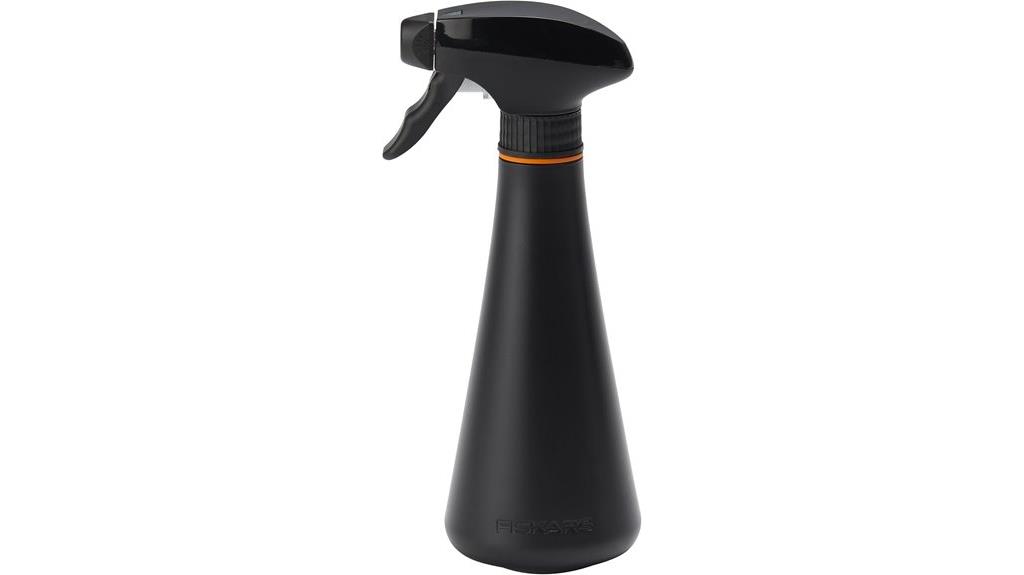
The Fiskars Plant Mister Spray Bottle (10 oz) is an ideal choice for gardeners who need a gentle, precise mist for delicate indoor and outdoor plants. Its fine, even spray helps hydrate fragile leaves and succulents without overwatering. Made with a lightweight, durable resin containing 30% recycled plastic, it’s eco-friendly and sturdy. The ergonomic grip and locking nozzle make it easy to handle and prevent accidental sprays. With a transparent, measurement-marked spout, I can water accurately. Its sleek design looks great on display, and the refillable, BPA-free construction guarantees a reliable, sustainable option for plant care.
Best For: indoor and outdoor gardeners seeking a stylish, eco-friendly spray bottle for precise, gentle watering of delicate plants and succulents.
Pros:
- Fine, even mist ideal for delicate plants and broad leaves
- Ergonomic design with a comfortable, easy-to-use trigger and locking nozzle
- Made with recycled plastic, eco-friendly, lightweight, and durable
Cons:
- Occasional difficulty reattaching the nozzle after cleaning
- Missing lids reported in some deliveries
- Limited capacity (10 oz) may require frequent refilling for larger watering needs
Flora Premium Plant Mister Spray Bottle
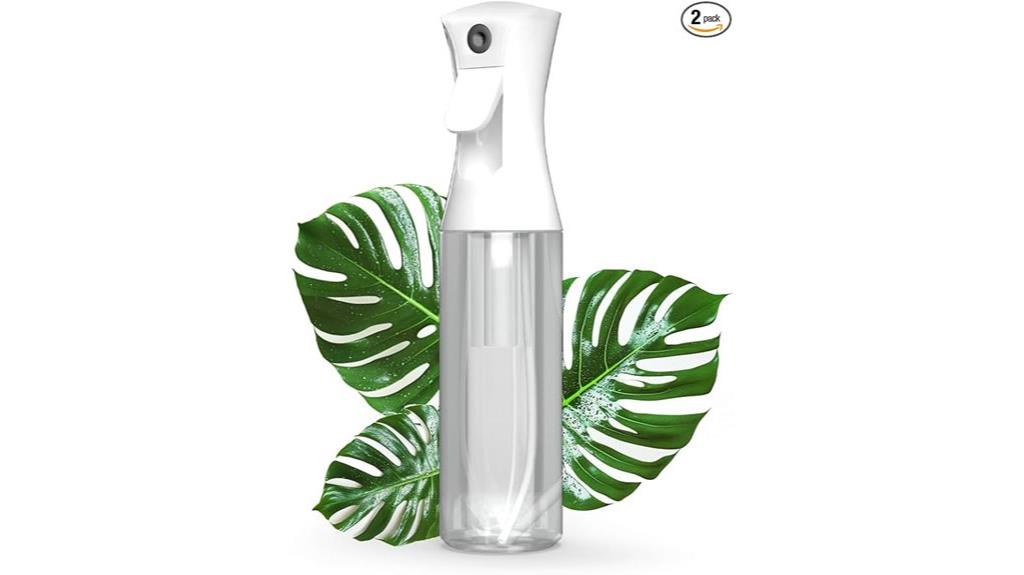
For anyone caring for delicate houseplants, seedlings, or young sprouts, the Flora Premium Plant Mister Spray Bottle offers precise hydration with its fine mist technology. Its gentle spray disperses humidity evenly without overwatering, making it perfect for sensitive plants. The ergonomic design reduces hand fatigue during extended misting sessions, and its lightweight, durable polycarbonate construction allows easy maneuvering around your indoor garden. With a 300ml capacity, it’s portable and reusable, requiring no batteries—just water and a quick wash. Plus, the Flora app enhances your plant care with personalized tips, reminders, and community support, making plant maintenance simple and efficient.
Best For: plant enthusiasts and indoor gardeners seeking a gentle, precise misting tool to care for delicate houseplants, seedlings, and young sprouts.
Pros:
- Ultra-fine mist technology provides gentle, even humidity without overwatering.
- Ergonomic, easy-squeeze design reduces hand fatigue during extended use.
- Smart app integration offers personalized care tips, reminders, and community support.
Cons:
- Some users have reported durability issues, such as device stoppage after brief use.
- No battery operation limits portability for outdoor or on-the-go use.
- Hand wash recommended, which may be inconvenient for frequent refilling.
Cleaning Spray Bottles for Plants, 2 Pack, 16.9 oz, Adjustable Nozzle

Cleaning spray bottles for plants, 2 pack, 16.9 oz, adjustable nozzle, stand out as an excellent choice for gardeners who value durability and versatility. Made from sturdy PET and PP materials, these bottles are heavier and more robust than typical options, resisting knocks and drops. They feature an extra nozzle with multiple spray patterns, including ultra-fine mist, thicker mist, and a long-range stream, giving you flexible control for watering and cleaning. The leak-proof design and adjustable nozzle ensure reliable operation and precise coverage. Perfect for water, cleaning solutions, or plant care, these bottles are reusable, easy to handle, and built to last.
Best For: Gardening enthusiasts, indoor plant owners, and cleaning enthusiasts seeking durable, versatile spray bottles for watering, cleaning, and plant care.
Pros:
- Made from sturdy PET and PP materials, ensuring durability and resistance to knocks and drops
- Includes an extra nozzle with multiple spray patterns, offering versatile watering and cleaning options
- Leak-proof design with adjustable nozzle for precise control and reliable operation
Cons:
- Hand-wash only; not dishwasher safe, requiring manual cleaning
- Slightly heavier than typical spray bottles, which may be less convenient for extended use
- Limited to 16.9 oz capacity, requiring refills during prolonged tasks
VIVOSUN Handheld Garden Pump Sprayer (0.8L)
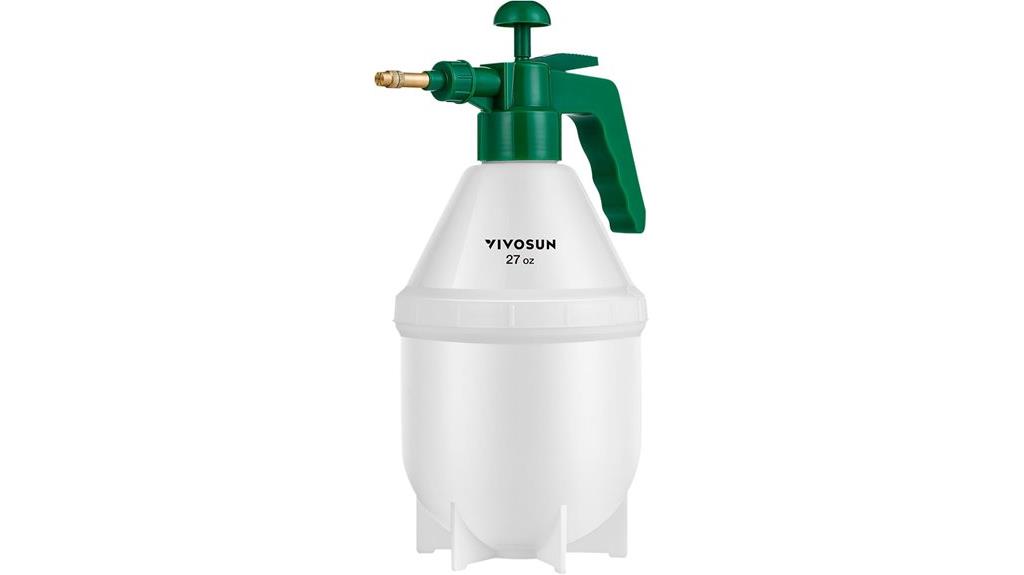
If you need a reliable and versatile spray bottle for watering plants, the VIVOSUN 0.8L Handheld Garden Pump Sprayer stands out as an excellent choice. Made of durable brass with a clear, calibrated bottle, it’s easy to monitor fluid levels and adjust the spray pattern with its brass nozzle. It’s lightweight, user-friendly, and suitable for indoor and outdoor use, including plant watering, pest control, and cleaning. Its ergonomic handle and pressure release valve make pumping effortless, even for those with arthritis. Many users praise its durability and effectiveness, noting it can spray plants up to 4 feet away, making plant care simple and efficient.
Best For: gardeners, plant enthusiasts, and outdoor users seeking a durable, easy-to-use sprayer for watering, pest control, and cleaning tasks.
Pros:
- Made of durable brass with adjustable nozzle for versatile spray patterns
- Lightweight and ergonomic design, suitable for users with arthritis
- Clear calibration markings for easy fluid level monitoring and efficient use
Cons:
- Potential for over-pressurization if not handled carefully, risking leaks or safety hazards
- Occasional nozzle clogging or residual odors requiring cleaning or part replacement
- Limited capacity (0.8L) may require frequent refilling for larger tasks
Happybuy 1 Gallon Stainless Steel Pump Sprayer
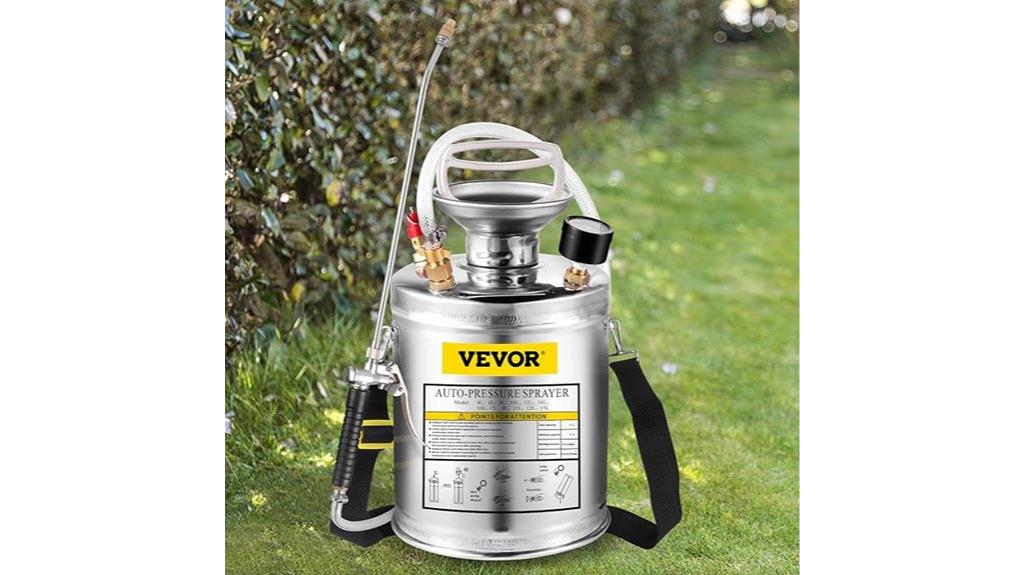
The Happybuy 1 Gallon Stainless Steel Pump Sprayer stands out as an ideal choice for serious gardeners and professionals seeking durability and consistent performance. Made from rust-proof, corrosion-resistant stainless steel, it’s built to last. Its adjustable brass nozzle switches easily from direct spray to fine mist, reaching up to 16 feet. The pressure gauge helps monitor pressure, while the safety valve ensures safe operation. With a comfortable handle, flexible hose, and shoulder strap, it’s easy to use and transport. Many users praise its sturdy construction and reliable pressure, making it perfect for gardening, sanitizing, or cleaning tasks. Upgrades like braided hoses can enhance its longevity even further.
Best For: Serious gardeners, lawn care professionals, and those needing a durable, high-performance sprayer for gardening, sanitizing, or cleaning tasks.
Pros:
- Made from rust-proof, corrosion-resistant stainless steel for lasting durability.
- Adjustable brass nozzle allows switching from direct spray to fine mist with a reach of up to 16 feet.
- Equipped with a pressure gauge and safety valve for safe, consistent operation.
Cons:
- Some users report hoses can be short or prone to kinking without upgrades.
- Loose D-rings on the shoulder strap may affect portability.
- Occasional leaks or early product failures reported by a few users, requiring potential upgrades or repairs.
Garden Pump Sprayer, 68oz/34oz Handheld Pressure Spray Bottle

The Munyonyo Garden Pump Sprayer is ideal for gardeners and outdoor enthusiasts who need a versatile, portable watering tool. Its 68oz or 34oz translucent polyethylene tank makes it easy to monitor liquid levels, while the lightweight design (just 11.3 ounces) ensures comfortable handling. The adjustable nozzle allows you to switch between a fine mist and a powerful jet, perfect for watering, fertilizing, or cleaning. With a safety valve to prevent over-pressurization and a non-slip handle, this sprayer is simple to operate and reliable. Whether watering plants or washing your car, its manual pumping system offers convenience without electricity, making it a handy addition to any toolkit.
Best For: gardeners, homeowners, and outdoor enthusiasts seeking a lightweight, versatile sprayer for watering, cleaning, and applying solutions without the need for electricity.
Pros:
- Portable and lightweight at only 11.3 ounces, easy to handle during extended use
- Adjustable nozzle for precise spray or jet mode, suitable for multiple tasks
- Transparent tank allows quick monitoring of liquid levels and easy refilling
Cons:
- Some users report nozzle leaks or sealing issues that can affect spray performance
- Pressure build-up problems may occur if not properly assembled or maintained
- The actual tank capacity may be less than advertised, leading to shorter usage intervals
HAUSHOF Battery Powered Garden Sprayer (35 Fl Oz, Rechargeable Electric Spray Bottle)
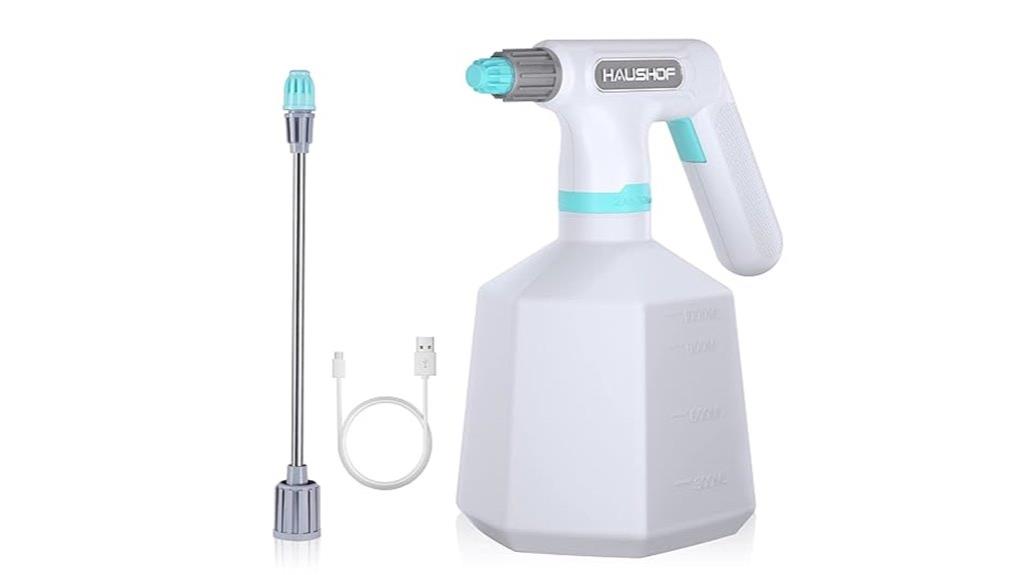
For gardeners seeking a versatile and easy-to-use sprayer, the HAUSHOF Battery Powered Garden Sprayer stands out with its adjustable nozzle, allowing me to switch effortlessly from a fine mist to a powerful jet stream. Its extended nozzle helps reach high or awkward spots without bending, and the leak-free spout makes refilling simple. The 35 oz translucent tank lets me monitor water levels easily, while the sturdy build ensures durability. The rechargeable 2000mAh battery provides 2-3 hours of continuous use, with indicator lights showing power status. Its multiple spray options make it perfect for watering, fertilizing, or applying insecticides efficiently and comfortably.
Best For: gardeners and outdoor enthusiasts seeking a versatile, rechargeable sprayer for watering, fertilizing, and applying insecticides with adjustable spray patterns.
Pros:
- Adjustable nozzle allows for a range of spray intensities from mist to jet stream.
- Extended nozzle facilitates reaching high or awkward spots without bending.
- Rechargeable 2000mAh battery provides long-lasting use of 2-3 hours per charge.
Cons:
- Blue ring handle connector may crack if overtightened, affecting durability.
- Trigger response can be slow or tricky, potentially causing frustration.
- Long nozzle is not bendable, limiting flexibility in certain applications.
VIVOSUN 1.35-Gallon Pump Pressure Sprayer
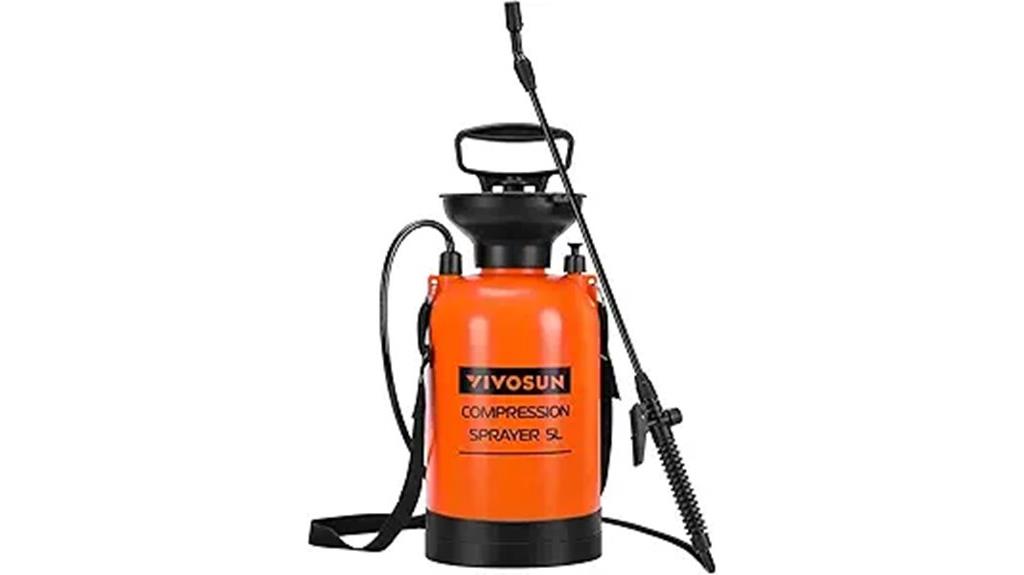
Looking for an easy-to-use sprayer that handles multiple household and gardening tasks? The VIVOSUN 1.35-Gallon Pump Pressure Sprayer fits the bill. Its translucent tank makes monitoring liquid levels simple, and the adjustable nozzles let you switch between water column and shower spray patterns. The ergonomic handle with a locking trigger reduces hand fatigue, while the 50-inch hose and 22-inch wand give you extended reach. Designed for versatility, it’s perfect for watering plants, spraying fertilizers, or cleaning. Just be mindful of potential leaks or durability issues over time; proper handling and regular maintenance will extend its lifespan.
Best For: DIY gardeners, household cleaners, and pet owners seeking an affordable, versatile spray tool for light to medium tasks.
Pros:
- Translucent tank allows easy monitoring of liquid levels
- Adjustable nozzles for multiple spray patterns including water column and shower
- Ergonomic handle with locking trigger reduces hand fatigue during extended use
Cons:
- Potential for leaks or durability issues over prolonged or harsh use
- Plastic components may be less robust compared to metal models
- Spray pattern consistency can vary depending on nozzle setting and maintenance
BeautifyBeauties Spray Bottle for Hair and More

If you need a versatile spray bottle that reliably delivers a fine mist, the BeautifyBeauties Spray Bottle for Hair and More is an excellent choice. It holds 10.1 ounces and features a 360-degree mister, making it easy to reach hard spots. With pre-compression technology, it sprays a gentle, consistent mist for 1.2 seconds at a fixed 1.25cc output, so you don’t have to squeeze hard. Perfect for styling hair, watering plants, cleaning, or aromatherapy, it’s made from durable plastic and mimics an aerosol spray. This eco-friendly, multi-purpose bottle is a handy addition to your beauty, gardening, or cleaning routine.
Best For: anyone seeking a reliable, versatile spray bottle for hairstyling, plant care, cleaning, or aromatherapy needs.
Pros:
- Continuous mist with consistent spray for 1.2 seconds at 1.25cc output, reducing effort.
- 360-degree mister allows easy spraying from any angle, including hard-to-reach spots.
- Durable plastic construction and eco-friendly design make it a reusable, sustainable choice.
Cons:
- May require initial adjustment to get accustomed to the pre-compression spray mechanism.
- Slightly larger size (9.8 inches tall) might be less suitable for very small storage spaces.
- Limited to 10.1 ounces capacity, which may require frequent refilling for intensive use.
Factors to Consider When Choosing Plant Misters and Spray Bottles

When choosing a plant mister or spray bottle, I consider factors like spray pattern options to guarantee even watering, as well as the material’s durability for long-term use. I also look at capacity and size to match my plant needs and ease of use, along with the design’s aesthetic to complement my space. These points help me pick the right tool for healthy, happy plants.
Spray Pattern Options
Choosing the right spray pattern is essential for effective plant care since it influences how water is delivered and how well it meets your plants’ needs. A fine mist distributes water evenly and gently, making it perfect for delicate plants or seedlings that can’t handle heavy watering. If you need targeted watering or want to clean leaves or hard-to-reach spots, a straight stream provides a concentrated jet. Adjustable nozzles give you the flexibility to switch between spray patterns quickly, making your watering routine more versatile. Selecting the appropriate pattern helps prevent overwatering, reduces water waste, and promotes healthier plants. By matching the spray type to your plant’s specific needs, you guarantee ideal hydration without stressing or damaging your greenery.
Material Durability
Selecting durable plant misters and spray bottles is essential because they need to withstand frequent use and cleaning without deteriorating. High-quality materials like BPA-free PET, reinforced polycarbonate, or stainless steel are ideal, as they resist corrosion, cracking, and chemical damage. Plastic components should be thickened and reinforced to prevent leaks, cracks, or breakage if dropped or handled roughly. Glass or stainless steel options offer enhanced longevity and a sleek look but are heavier and more fragile, requiring careful handling. Choosing materials with corrosion-resistant properties guarantees the bottle remains functional when used with water, fertilizers, or cleaning solutions. Investing in durable materials not only extends the lifespan of your spray bottles but also guarantees consistent performance, making plant care easier and more reliable over time.
Capacity and Size
The capacity and size of plant misters and spray bottles directly impact how effectively they fit into your watering routine. Smaller bottles, like 200ml or 16oz, are perfect for detailed misting of delicate plants or indoor use, while larger capacities—up to a gallon—are better suited for extensive watering or outdoor gardening. Consider how much space you have and how often you’ll need to refill; compact bottles are easier to maneuver indoors, but larger ones reduce frequent refills. Portability also matters: lightweight, smaller bottles are ideal for quick, targeted misting, whereas bigger ones require more storage but are more efficient for larger jobs. Choosing the right size helps you maintain a consistent watering routine without unnecessary bulk or inconvenience.
Ease of Use
When evaluating plant misters and spray bottles, ease of use is a crucial factor that can make watering and care routines more efficient. Look for bottles with adjustable nozzles so you can easily switch between a fine mist for delicate leaves or a direct stream for watering roots. An ergonomic design with comfortable triggers or handles helps reduce hand fatigue during extended use. Clear measurement markings or indicators are indispensable for precise watering or mixing solutions. Lightweight, balanced models are easier to maneuver around delicate or hard-to-reach plants, making the process less cumbersome. Finally, choose bottles with simple, intuitive operation and easy refilling mechanisms to save time and avoid frustration. These features ensure you can care for your plants comfortably and effectively.
Design Aesthetics
Since the design aesthetic of a plant mister or spray bottle can substantially enhance your indoor decor, it’s worth considering how these tools complement your overall style. Materials like glass, brass, or decorative plastics can add a sophisticated or charming touch, fitting seamlessly into vintage, modern, or steampunk interiors. Color options such as pastels, metallic finishes, or transparent designs give you the freedom to match your bottles with your garden or room decor. Artistic details, like pumpkin motifs or antique accents, can turn a functional item into a stylish decor piece. A well-chosen design not only elevates your space but also encourages consistent use by making the tools more attractive, enjoyable, and aligned with your personal aesthetic.
Leak Prevention Features
Choosing plant misters and spray bottles with effective leak prevention features is essential to avoid messes and wasted liquids. Look for bottles with tight-sealing caps and O-ring gaskets, which keep fluids secure during use and storage at various angles. Adjustable nozzles with locking mechanisms help prevent accidental sprays and over-pressurization, reducing leaks. Durable construction with high-quality seals ensures the bottle withstands repeated use and exposure to different liquids without seepage. Some models include 360° caps or anti-drip valves that prevent leaks even when the bottle is tilted or inverted. Proper assembly is also key—fully inserting the nozzle and tightening caps securely can prevent most leaks. Paying attention to these features ensures a cleaner, more efficient watering experience for your plants.
Versatility and Functions
A versatile plant mister should provide adjustable spray patterns, such as fine mist and jet streams, to meet different watering, cleaning, and humidity needs. This flexibility allows me to gently hydrate delicate plants or target stubborn dirt on leaves. Multi-functionality enhances its usefulness, whether I’m watering, cleaning, controlling humidity, or managing pests. Choosing eco-friendly, reusable materials like BPA-free plastic or glass makes the bottle sustainable and safe for my plants. Compatibility with various liquids—water, nutrients, or cleaning solutions—adds to its versatility. Ergonomic features like a comfortable grip and leak-proof design make handling easier during different tasks. Overall, a versatile spray bottle simplifies multiple plant care routines, saving me time and effort while keeping my plants healthy and thriving.
Frequently Asked Questions
Which Type of Spray Bottle Is Best for Delicate Plant Leaves?
When it comes to spraying delicate plant leaves, I prefer using a fine-mist spray bottle. It disperses water evenly without damaging the foliage or causing over-saturation. I recommend a glass or high-quality plastic bottle with a adjustable nozzle to control the spray’s intensity. This way, I can keep my plants hydrated and healthy without risking leaf injury. A gentle, fine mist truly makes all the difference!
How Do I Prevent Mineral Buildup in My Spray Bottle?
To prevent mineral buildup in your spray bottle, I recommend regularly flushing it with distilled or rainwater. After each use, rinse the nozzle and bottle with warm water to remove any residue. Avoid using hard tap water, which contains minerals that can clog the spray mechanism. Additionally, cleaning the nozzle weekly with vinegar helps dissolve mineral deposits, keeping your spray bottle functioning smoothly and ensuring your plants stay happy and healthy.
Are Battery-Powered Sprayers Suitable for All Plant Types?
Battery-powered sprayers can be great for many plants, making watering and misting easier. However, I wouldn’t say they’re suitable for all plant types. For delicate or sensitive plants, manual sprayers give you more control and gentler application. For larger collections or tougher plants, battery-powered options save time and effort. Just make sure to choose a model that offers adjustable spray settings to match your plants’ needs perfectly.
How Often Should I Clean My Plant Mister or Spray Bottle?
Did you know that bacteria can multiply rapidly in stagnant water, doubling every 20 minutes? That’s why I recommend cleaning my plant mister or spray bottle at least once a week. Regular cleaning prevents mold, bacteria, and mineral build-up, ensuring my plants stay healthy and safe from potential infections. Plus, a clean spray bottle works better, giving me the perfect mist every time. It’s an easy step for happy, thriving plants!
Can Spray Bottles Be Used for Fertilizing Plants Effectively?
Yes, spray bottles can be effective for fertilizing plants, but I recommend using a diluted liquid fertilizer specifically designed for foliage. I always mix the fertilizer according to the instructions, ensuring I don’t overdo it. Then, I spray it evenly onto the leaves, avoiding excessive runoff. This method helps plants absorb nutrients quickly and promotes healthy, lush growth without the risk of root over-fertilization.
Conclusion
Choosing the right plant mister or spray bottle is like finding the perfect watering partner—one that nurtures growth without overwhelming. Remember, a good spray bottle isn’t just about misting; it’s about creating a tiny raincloud for your plants’ happiness. So, pick wisely, and let your green friends flourish under your caring touch. After all, a well-loved plant is a reflection of your dedication—nurture it, and it will thrive.
